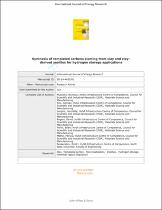 ResearchSpace
ResearchSpace
Synthesis of templated carbons starting from clay and clay-derived zeolites for hydrogen storage applications
JavaScript is disabled for your browser. Some features of this site may not work without it.
- ResearchSpace
- →
- Research Publications/Outputs
- →
- Journal Articles
- →
- View Item
| dc.contributor.author |
Musyoka, Nicholas M

|
|
| dc.contributor.author |
Ren, Jianwei

|
|
| dc.contributor.author |
Langmi, Henrietta W

|
|
| dc.contributor.author |
Rogers, DEC

|
|
| dc.contributor.author |
North, Brian C

|
|
| dc.contributor.author |
Mathe, Mahlanyane K

|
|
| dc.contributor.author |
Bessarabov, D

|
|
| dc.date.accessioned | 2015-08-19T10:37:21Z | |
| dc.date.available | 2015-08-19T10:37:21Z | |
| dc.date.issued | 2014-10 | |
| dc.identifier.citation | Musyoka, N.M., Ren, J., Langmi, H.W., Rogers, D.E.C., North, B.C., Mathe, M. and Bessarabov, D. 2014. Synthesis of templated carbons starting from clay and clay-derived zeolites for hydrogen storage applications. International Journal of Energy Research, vol. 39, pp 494-503 | en_US |
| dc.identifier.issn | 0363-907X | |
| dc.identifier.uri | http://onlinelibrary.wiley.com/doi/10.1002/er.3261/epdf | |
| dc.identifier.uri | http://hdl.handle.net/10204/8038 | |
| dc.identifier.uri | https://doi.org/10.1002/er.3261 | |
| dc.description | Copyright: 2015 John Wiley& Sons. Due to copyright restrictions, the attached PDF file only contains the abstract of the full text item. For access to the full text item, please consult the publisher's website. The definitive version of the work is published in the International Journal of Energy Research | en_US |
| dc.description.abstract | Clay and its recrystallized zeolitic derivatives were used in this study as templating agents for carbon nanostructured materials. The conventional nanocasting process that involves impregnation with furfural alcohol and subsequent chemical vapour deposition was followed. Several techniques such as X-ray diffraction (XRD), scanning electron microscopy (SEM), thermo-gravimetric analysis (TGA) and surface area analysis were used to characterize the parent templating materials including the resulting nanocasted carbons. The study demonstrated that there is greater potential for the use of value-added clays rather than their pristine form and hence presents a cost-effective alternative for producing carbonaceous materials with more attractive properties for hydrogen storage applications. | en_US |
| dc.language.iso | en | en_US |
| dc.publisher | John Wiley & Sons | en_US |
| dc.relation.ispartofseries | Workflow;13714 | |
| dc.subject | Clay | en_US |
| dc.subject | Templated carbon | en_US |
| dc.subject | Hydrogen storage | en_US |
| dc.subject | Recrystallization | en_US |
| dc.subject | Zeolites | en_US |
| dc.subject | Chemical vapour deposition | en_US |
| dc.title | Synthesis of templated carbons starting from clay and clay-derived zeolites for hydrogen storage applications | en_US |
| dc.type | Article | en_US |
| dc.identifier.apacitation | Musyoka, N. M., Ren, J., Langmi, H. W., Rogers, D., North, B. C., Mathe, M. K., & Bessarabov, D. (2014). Synthesis of templated carbons starting from clay and clay-derived zeolites for hydrogen storage applications. http://hdl.handle.net/10204/8038 | en_ZA |
| dc.identifier.chicagocitation | Musyoka, Nicholas M, Jianwei Ren, Henrietta W Langmi, DEC Rogers, Brian C North, Mahlanyane K Mathe, and D Bessarabov "Synthesis of templated carbons starting from clay and clay-derived zeolites for hydrogen storage applications." (2014) http://hdl.handle.net/10204/8038 | en_ZA |
| dc.identifier.vancouvercitation | Musyoka NM, Ren J, Langmi HW, Rogers D, North BC, Mathe MK, et al. Synthesis of templated carbons starting from clay and clay-derived zeolites for hydrogen storage applications. 2014; http://hdl.handle.net/10204/8038. | en_ZA |
| dc.identifier.ris | TY - Article AU - Musyoka, Nicholas M AU - Ren, Jianwei AU - Langmi, Henrietta W AU - Rogers, DEC AU - North, Brian C AU - Mathe, Mahlanyane K AU - Bessarabov, D AB - Clay and its recrystallized zeolitic derivatives were used in this study as templating agents for carbon nanostructured materials. The conventional nanocasting process that involves impregnation with furfural alcohol and subsequent chemical vapour deposition was followed. Several techniques such as X-ray diffraction (XRD), scanning electron microscopy (SEM), thermo-gravimetric analysis (TGA) and surface area analysis were used to characterize the parent templating materials including the resulting nanocasted carbons. The study demonstrated that there is greater potential for the use of value-added clays rather than their pristine form and hence presents a cost-effective alternative for producing carbonaceous materials with more attractive properties for hydrogen storage applications. DA - 2014-10 DB - ResearchSpace DP - CSIR KW - Clay KW - Templated carbon KW - Hydrogen storage KW - Recrystallization KW - Zeolites KW - Chemical vapour deposition LK - https://researchspace.csir.co.za PY - 2014 SM - 0363-907X T1 - Synthesis of templated carbons starting from clay and clay-derived zeolites for hydrogen storage applications TI - Synthesis of templated carbons starting from clay and clay-derived zeolites for hydrogen storage applications UR - http://hdl.handle.net/10204/8038 ER - | en_ZA |





